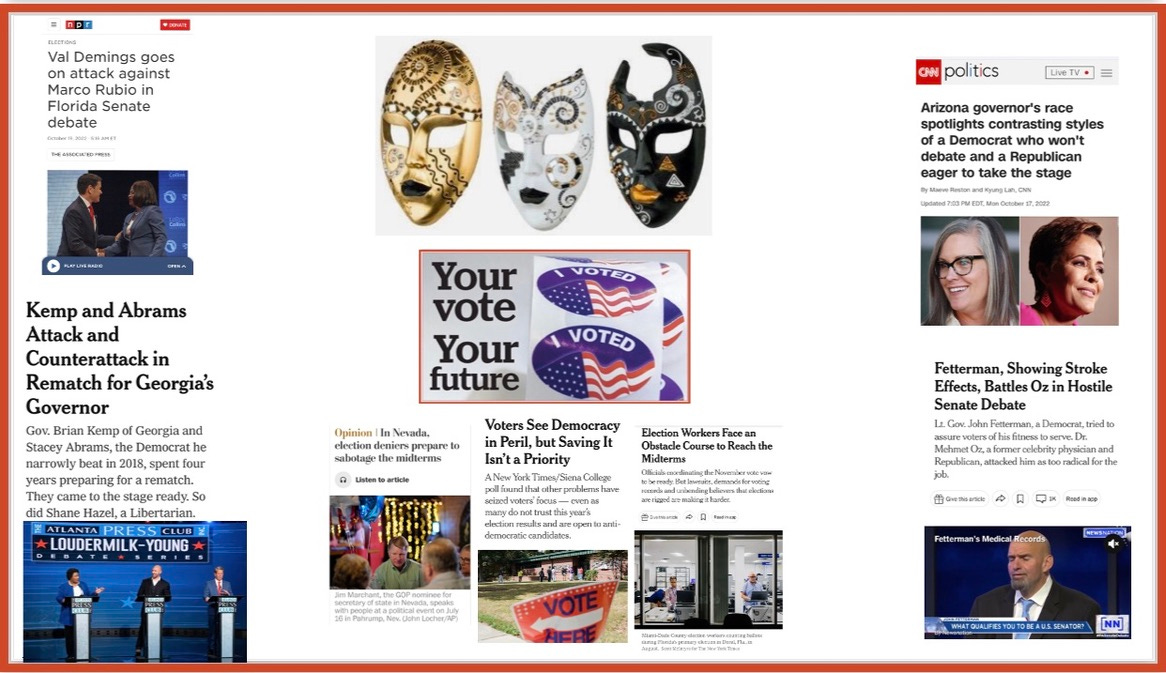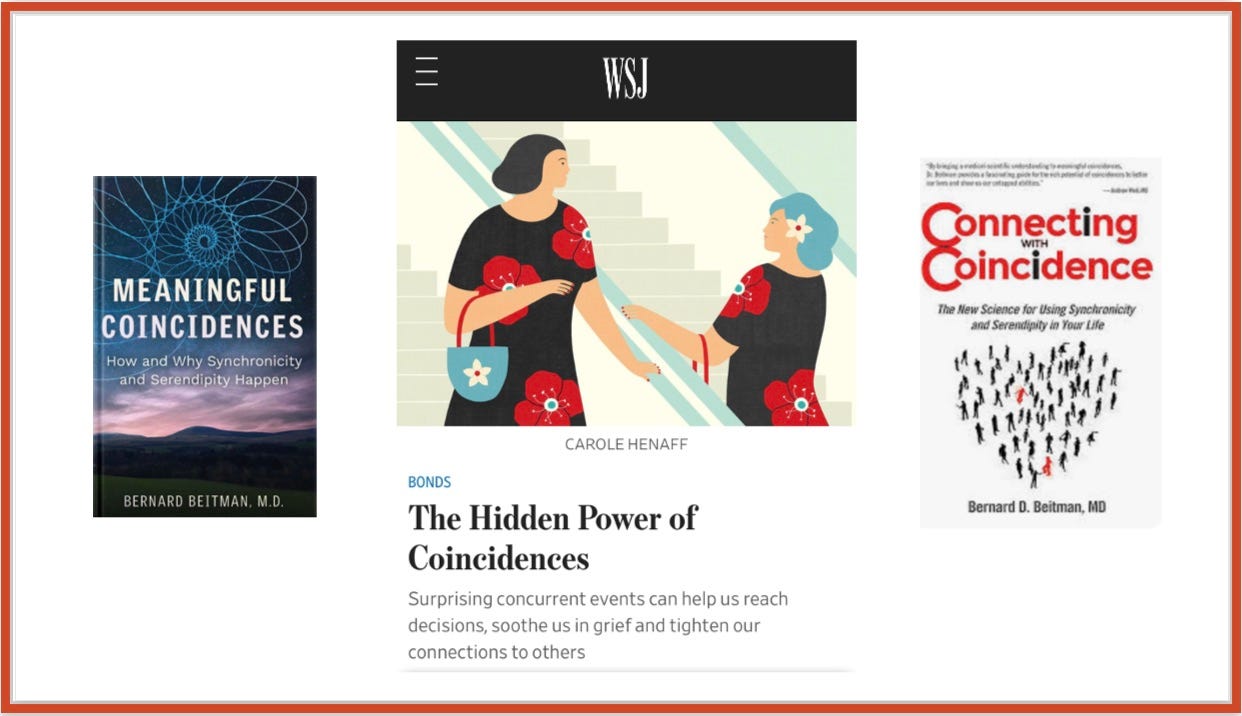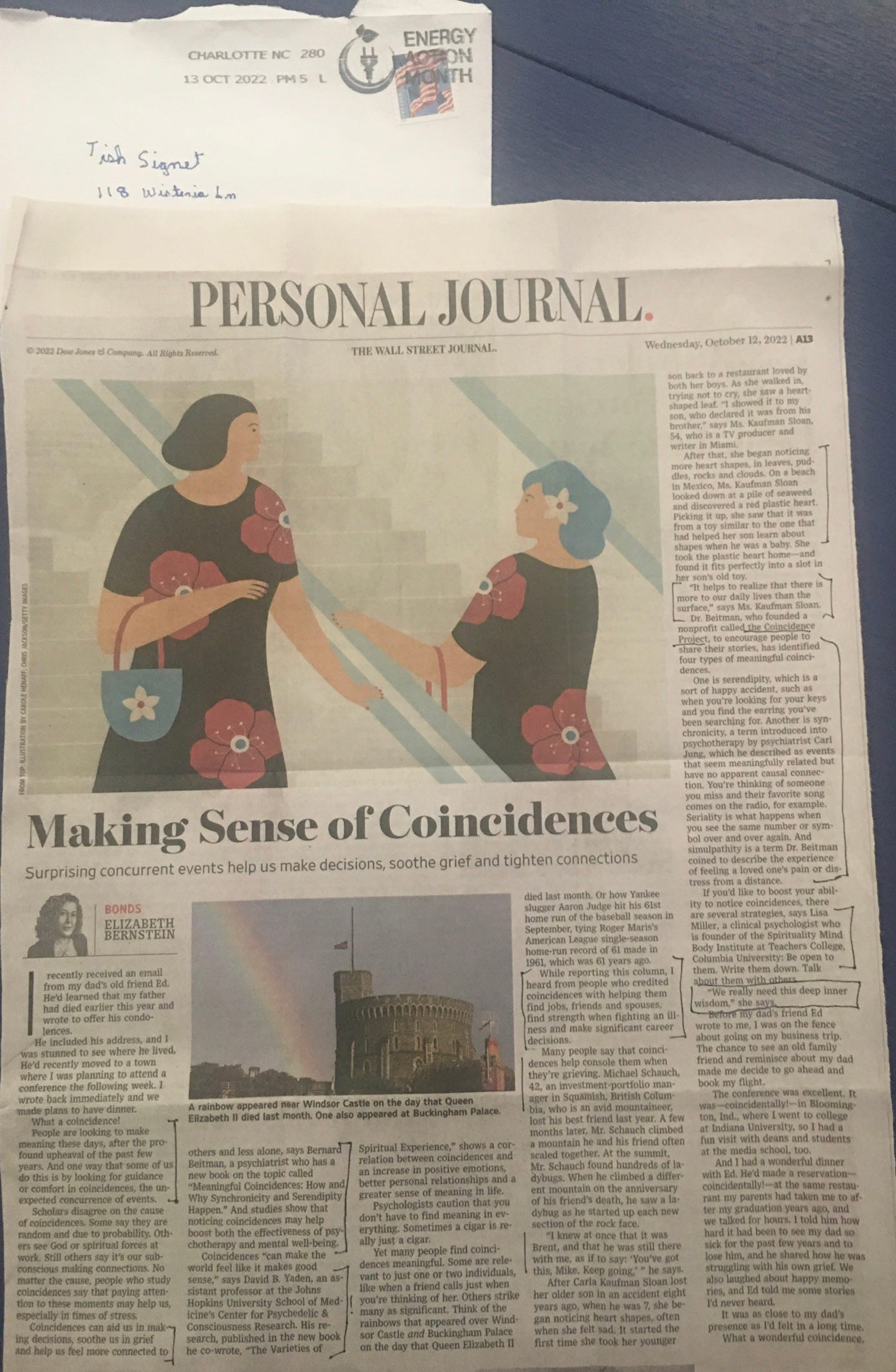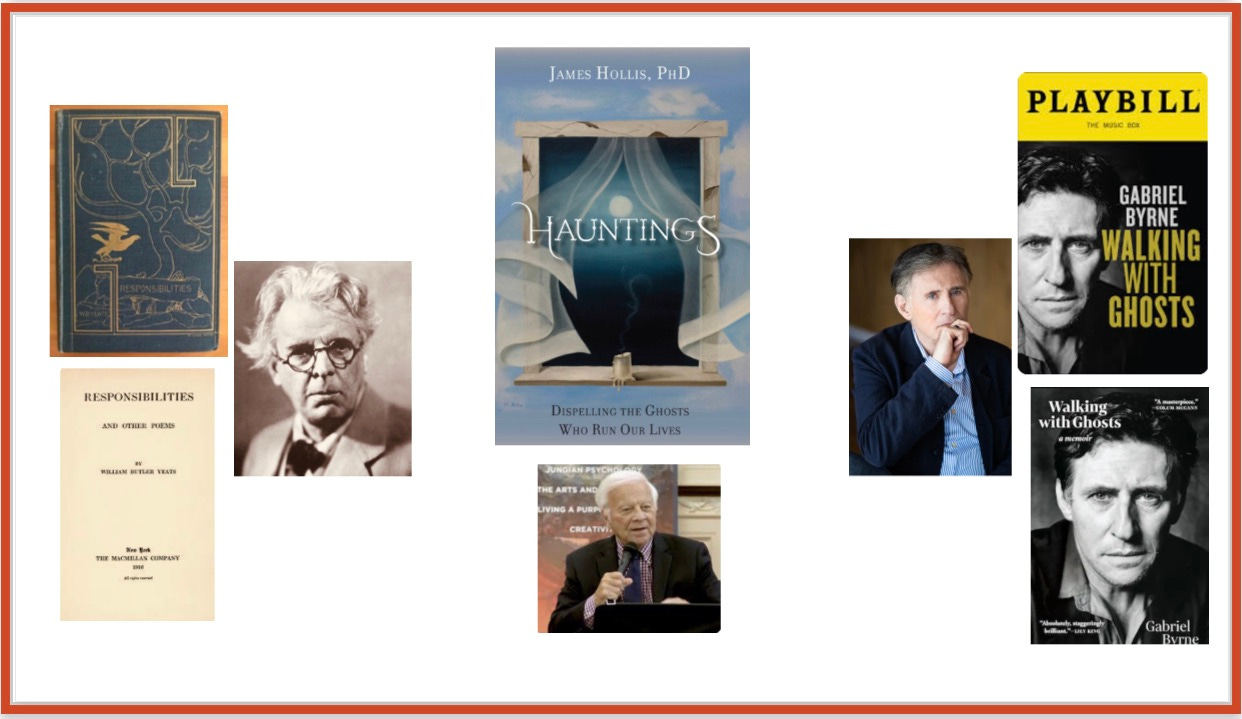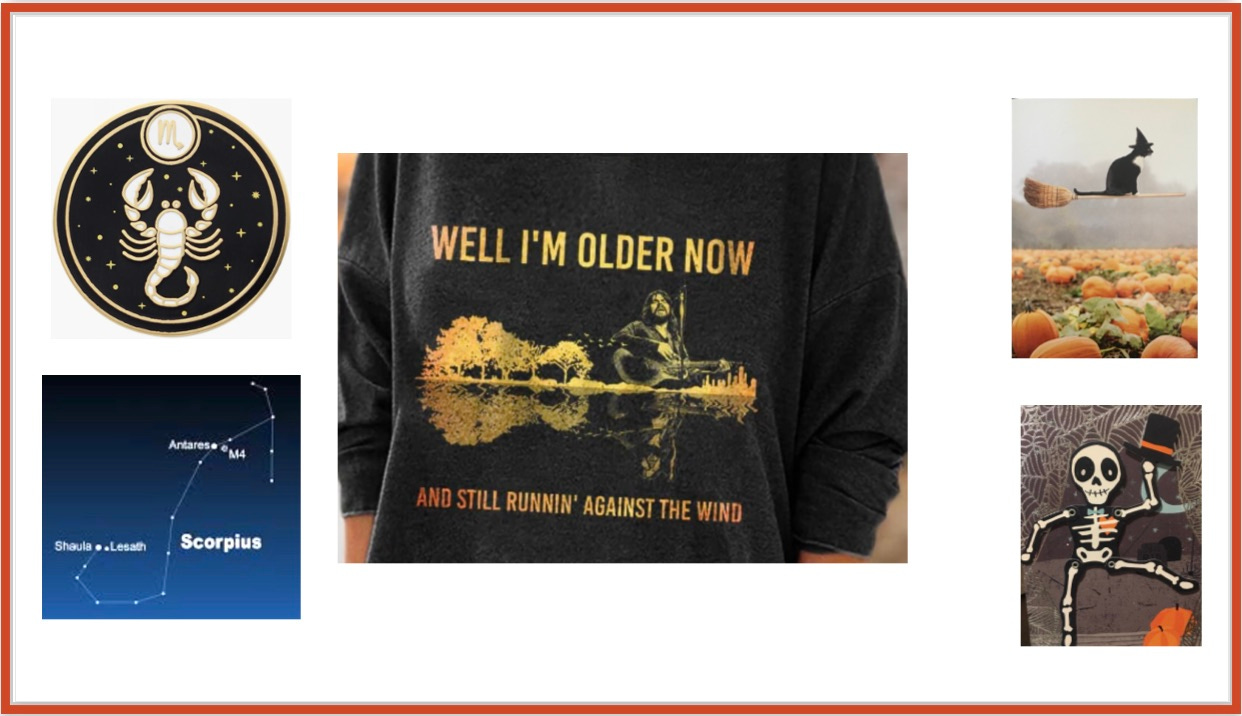Greetings, these Scorpio days of Halloween haunts and midterm masquerade. For spooky it’s a news-season hard to top.
First, the masks…
After now-years of COVID-shield ones, if you visit health-care, retirement-community and other heavily masked settings, you may find this month’s arrival of the Halloween-celebratory kind along with them a bit jarring.
I do. Which got me curious about the long and storied traditions around the latter masquerade variety, often beautiful and elaborately decorated accessories to mystery.
Masque, masquerade and midterms
That kind of masque, of the sort pictured and spelled this way, dates back to a specific form of dramatic-entertainment from the late Middle Ages and firmly established in 16th and 17th Century England and Europe. These masques were performances designed to elicit favor of the powerful at royal court via ornate disguises (masques), pantomime, cleverly worded scripts, dancing and song.
From a newShrink-eye view this so described the current news’ countdown-days of political campaigns devoted to message- and counter-message, appearances and currying favor of voters and king-makers alike. This visual sampling of events, headlines and issues illustrates a sense of that spectacle.
In Jung’s soul/psychodynamic terms masque also illustrates an apt metaphor for the persona. That’s translated literally as the protective clothing or masks that the conscious ego, both individual and collective, “wears” or presents to others and the world. (Persona and ego are both aspects of our lived-experience of conscious human reality. These are distinct, in addition to, our lived-experience of unconscious reality also known as the soul or psyche.)
Persona may be viewed as simply packaging, not necessarily false or deceptive — although as a conscious contrivance it may be. Teasing-out and parsing what is persona or mask of messaging and story vs quantifiable content, fact and substance are familiar ground for those working on both journalist and PR sides of the news and public-affairs marketplace of ideas.
Next week’s newShrink will be a pre-Election Day round-up edition of mostly headlines, cartoons and a variety of related material. Please do send me your shareable ideas and selected related articles, cartoons or photos.
🔵
Next-up, a Wall Street Journal news article sent to me, uncannily arriving in the startling, over-the-transom way that often signals highly charged unconscious stuff such as synchronicity, dream images, or both. This is such an eerie example for newShrink, combining news item, soul-theme-subject and case snapshot of how such unconscious processes work, that I’ll try in discussion below to describe the process much as it came to me.
First, the content…
In synch
With relevant personal and interview examples, the recent WSJ piece pictured at center presents a well-reported update on a vast range of well-grounded research, study and applied work with the phenomenon depth psychologists know as synchronicity. That’s coincidence that has meaningful resonance from the deeply unconscious level.
An example to illustrate the difference: If I’ve been thinking and jotting on my routine to-do list to text or call for a return-hair appointment that I’d dashed out without making last time — and my stylist or receptionist calls me to check just as I was texting, that’s coincidence. If all of the above happens, with the stylist calling me — and I had dashed out hastily last time after she, my long-loved and trusted friend and stylist, blasted me with an angry tirade, accusations, comparisons of me unfavorably with my or her mother, used epithets and nasty language she knows to be painfully triggering of things she knows as part of our relationship, and/or all of the above, and I have been thinking, starting to, second guessing whether and how to reconnect and somehow fix this rupture with her… THAT call from her would be synchronicity!
Fortunately, many are more enjoyable than this example.
Post Notes at the very bottom after closing of today’s edition list links to articles and reviews of books discussed here. That includes the link to the online WSJ article, for those who can get past the Journal’s very restrictive and relatively pricey paywall. (A photo illustration of the full hard-copy clipping sent to me, included for discussion below, can also be zoomed for reading the full article minus some photos.)
Soul-engaged psychology inching toward mainline? (sort of…)
Heartening, and to me surprising, is the vast range and significantly credentialed MDs, research scholars, programs and collected case material cited on the subject here. For example:
🔷 Dr. Bernard Beitman, Yale- and Stanford-educated MD psychiatrist, author of the two books pictured above. Founder of The Coincidence Project, podcast and www.coincider.com website, his work seeks both to categorize and demonstrate benefits of our attuning to meaningful coincidences, synchronicities.
Two notes on terminology: Beitman cites and acknowledges Jung’s seminal work on the topic, though his four-part attempt to “type” meaningful coincidences would benefit from Jung’s greater clarity and simplicity of terminology. Interchangeable use of coincidences and synchronicities by Beitman, the journalist and others here is unnecessarily confusing, for synchronicity is by definition meaningful, unconsciously charged coincidence. All synchronicities are coincidences, but not vice versa. In this sense, all of his four “kinds of coincidences” are actually varieties of synchronicity, except purely coincidental serendipity, just happy-accident (The repetition of seriality or repeated numbers Beitman cites is noticed and tracked only in connection with a personal meaning that makes the pattern synchronistic.)
Beitman’s coining of the awkward term simulpathity, to describe experience of another’s feelings from a distance, is unnecessary and clumsy. The phenomenon is known and well-described among “four clairs-” experienced across distance: clairvoyance (seeing), clairaudience (hearing), claircognition (knowing), and clairsentience (feeling, both emotional and physical).
🔷 David B Yaden, assistant professor at Johns Hopkins University school of Medicine Center for Psychedelic & Consciousness Research, has cowritten a new book, The Varieties of Spiritual Experience (a title somewhat joltingly close to William James’ classic describing the experience as religious.) Yaden captures a bit of the primacy of synchronicity as inside-out phenomenological, felt-experience in noting that attention to it “can make the world feel like it makes good sense.”
🔷 Lisa Miller, clinical psychologist and founder of the Spirituality Mind Body Institute at Teacher’s College of Columbia University, offers advice regarding synchronicity experiences — which I echo, and would add dreams:
“Be open to them. Write them down and refer back as events prompt it. Talk about them with others. We need this deep inner wisdom.”
Some caveats
With this last comment Miller touches on my two pauses about all of these largely quantitative efforts, notes of caution that are substantial despite my also-enthusiastic welcome of this mainstreaming of such soul-focused work in popular culture and medicine.
🌀One is that all of these are needed, laudable efforts to collect, count, measure, categorize, map an “anatomy” of and uses for coincidence or synchronicity. These quantitative efforts, like collecting, gathering and studying images, content and symbolism into dream dictionaries, are useful endeavors and resources of the conscious ego. Yet allowing in, learning and benefiting also from the deeply individual meanings from the unconscious level of mystery requires relaxing and relativizing of that insatiable need of the ego to control, prove or disprove, define, limit, categorize. That entails a thoroughly defined and applied psychology of the (autonomous) unconscious. There’s little of that dimension here beyond a nod to Jung’s early defining of synchronicity and work with quantum physicist Wolfgang Pauli.
🌀A more glaring issue is utter absence or mention of dream experience, images or their many synchronistic connections in waking life. None is noted in the article — and more surprising given the extent of his coincidence work, nothing about dream even as an index reference or example has surfaced in my reading thus far of Beitman’s exhaustively cited latest book (above left). I find this disturbing based on both clinical work and long personal experience. Dream images often point to meaning that appears in waking life as synchronicity or through the body — and vice versa. Jung and many after him have described dreams as the royal way that we glimpse unconscious information. Synchronicity and embodied sensation or symptom are the other two.
Now, as for that spooky-special delivery…
Over-the-transom
This was a news item about synchronicity: The Wall Street Journal article, per my news- and depth psychology newShrink focus. Here’s what the “meaning” part looks like.
The sender is one of the most synchronistic-imaginable to me on this subject: my 94-year-old heart-&-soul “uncle.” With him I’ve shared since my late teens a passion for all things Jungian — particularly around synchronicity and dream. That’s been readings, audiotapes of lectures, writings. Jung’s full Collected Works and much of the rest of my uncle’s extensive library are now housed, and loaned with him back and forth, from among my own cherished volumes…
… This reader, not only of newShrink, has likely read more, more varied and over more time of stuff I’ve ever written, than about anyone. Uniquely in my personal circle he slogged through my entire 300-plus-page dissertation tome, noting thought-provoking comments throughout. (One was his respectful question of my not citing more busines- and moderate-conservative news outlets… like The Wall Street Journal!)
… A couple of weeks ago this article was published, sent and received with synchronistic/significant timing given our long personal relationship: I’d been thinking to connect for the first time since midsummer, in hope of sometime soon celebrating this weekend’s birthday of his wife/my aunt — her 94th.
… The piece was received as a hard copy addressed, in the beloved sender’s recognized tight script and characteristic lack of excessive (ie. any!) note of greeting or explanation. (My describing him even this much here will not delight him; I hope perhaps he hasn’t read this when I see him Sunday!)
Finally, perhaps most compelling, the piece from the WSJ, venerable stalwart of rational pragmatism, is a literal old-school, newsprint hard-copy newspaper clipping. Along with song lyrics, highway signs and verbal phrases or quotes, my most vividly significant dream images have long tended to appear as crusty newspaper clippings and headlines!
Kind of like this…
🔵
Next: not so much in counterpoint, as “yes, AND,” to the above…
Hauntings
I was absorbing the Beitman book’s exhaustive efforts on the quantitative, scientifically measurable dimensions of synchronicity or meaningful coincidence, when the different eloquent voices below arrived in my inbox and on the news. They brought the phenomenological perspective of the unconscious psyche or soul, the felt- and lived experience.
First (pictured at center column) — perhaps a playful Halloween-week marketing nod to its title: From a Jung Center’s Chiron Books came a pitch for this 2015 book Hauntings: Dispelling the Ghosts Who Run Our Lives. (Also recommended, the more general 2021 volume The Best of James Hollis: Wisdom for the Inner Journey.)
Hollis is a Jungian analyst, author, and professor I was fortunate to experience both as teacher and author. I’ve particularly valued his extensive work and writing on psychological maturity in contemporary America. Useful for adults of all ages is his concept of psychological first (ego forming ) adulthood and later second (ego relativizing, soul-reclaiming) adulthood. (I have frequently hoped that columnist/author David Brooks, in his efforts to deal with and write on this topic, might more thoroughly absorb and make use of Hollis’ work and ideas.)
This timely post from reader and wonderful quote-curator Ann Ahern Allen nicely illustrates this maturity-task of relativizing the ego.
In Hauntings Hollis considers one’s transformation via the unconscious world of the soul, where we are all “haunted” by the “ghost/spirit” figures from memory, ancestral and parental influences, and universal archetypes from human antiquity. These may arrive as inner voices of dream, untold story, synchronicity or embodied impulse. The book’s chapter “On Synchronicity and Quantum Physics” provides examples from Hollis’ own everyday life with a thorough description of the crucial role that synchronicity plays as a meaning-making connection between external events and our unconscious/soul experience of them.
In the chapter, The Unlived Life, I relished discussion of renowned Irish poet and statesman William Butler Yeats and his writing (pictured above left.) Curiously prompted to explore Yeats further (beyond really liking this photo of him!) I discovered with amazement his vast range. He straddled and spoke across those disparate newShrink realms, the soul and his contemporary society’s news and politics. Yeats won the 1923 Nobel Prize in literature for his poetry meshing 19th century Romanticism with the bold language of modernism. Meanwhile he also served as an Irish Senator from 1922 until his retirement in 1928. (Imagining this combination by any contemporary elected politician is quite impossible!)
Citing Yeats’ epigraph from the poem “Responsibilities,” in dreams begin responsibilities,” Hollis echoes Jung’s admonition that our becoming awake and aware of the reality of the autonomous unconscious or soul brings with it a moral obligation to consider and incorporate it in the way we lead our lives and our work. From Hollis:
Dreams come from the Self, the deep organic wisdom that gifts us with the daunting summons to become… All of us fail in so many ways to show up, to step into the largeness of the soul. The unconscious remembers everything. The greatest haunting we all suffer is the lost relationship with the soul, with the original mode of being that proved too costly for us to sustain in the youthful ego’s necessity to adapt… Jung is right when he claims individuation’s task is synonymous to our ancestors’ call to a vocation: It obliges us to serve that which pulls us deeper than is comfortable, wider than is convenient.”
At midweek on morning news from NYC came glorious Irish actor, acclaimed memoirist Gabriel Byrne (pictured at right) now opening his one-man play version of his 2020 memoir “Walking With Ghosts” on Broadway. All of it perfectly attuned to today’s haunting ghosts and themes — quite literally the title, images and ideas. (For full disclosure, this actor had me at his hotly soulful shrink-role in HBO’s In Treatment years ago!)
As reviews of the memoir in The Washington Post and Guardian describe, echoed in early preview of the play (in links listed below), Byrne’s psychological awareness combined with elegiac writing are astonishing. Describing motivation for both works:
“My own belief is that every single person has an extraordinary story to tell, and I’ve put mine down, not because I want people to think or look at my life. I want people to look at their own.
Wrenching, and ringing painfully true, in the memoir is Byrne’s account of his sexual molestation by a favorite priest when he was 11, a traumatic event he buried and self-medicated for years:
“I’ve been picking at it with a pin since — afraid to use a jackhammer.”
In all of these haunting themes today, with all of our assorted ghosts, the point is not burial, eradication — or for us to become ghostbusters.
On this with Hollis’ book title, my mind’s ear makes a slight tweak, from dispelling to more of a de-spelling. That means daring to engage consciously with those parts of us and memory that have been submerged or banished. It’s akin to bringing them home, allowing them voice, asking why they are here, what they bring to us… and listening.
I’m reminded of the Sufi poet’s urging: Invite them in!
“The Guest House,” by Jelaluddin Rumi (translation by Coleman Barks)
This being human is a guest house/Every morning a new arrival./A joy, a depression, a meanness,/some momentary awareness comes as an unexpected visitor./Welcome and entertain them all!/Even if they are a crowd of sorrows,/who violently sweep your house /empty of its furniture,/still, treat each guest honorably./He may be clearing you out/for some new delight./The dark thought, the shame, the sadness./Meet them at the door smiling and invite them in./Be grateful for whoever comes, because each has been sent as a guide from beyond.
Today’s closing note touches back on the other side of the aunt-and-uncle story above,
Birthdays!
Beginning with the centerpiece musical against the wind message from the 1980 Bob Seger hit, this tribute is for those special Scorpios (son among them, as well as aunt) — whose day comes amid this season’s ghouls, fast-waning daylight, plus political chaos that seems endless.
I’m so glad you were born, and wish you a year of surprising magic ahead.
At left (from online Brittanica): Constellation Scorpius, who in the Greek myth was placed visibly by earth goddess Gaia in the night sky to reward his bravery. Using his scorpion-sting, Scorpius saved all of the world’s animals from vicious-hunter Orion who had vowed to slay every animal on earth.
By night the legendary Scorpius chases starry Orion across the sky… (By day, kitty-witch here and skeletal company, at right, seem to have that one covered.)
May all your haunting ghosts be loving and fun…or at least fascinating.
And, that is all I have! Talk to you next week.
🦋💙 tish
… it is important that awake people be awake,
or a breaking line may discourage them back to sleep;
the signals we give — yes or no, or maybe —
should be clear: the darkness around us is deep.
— William Stafford, “A Ritual to Read to_Each Other”
🔵
Post Notes
Making Sense of Coincidences (WSJ)
Coincidences and The Meaning of Life (The Atlantic, 2016)
Review of Hauntings: Dispelling the Ghosts Who Run Our Lives (New York Journal of Books, 2015)
Gabriel Byrne’s Walking With Ghosts is a Revelation in Unexpected Ways (The Washington Post, 2020)
Review of Walking With Ghosts by Gabriel Byrne, An Elegy for Ireland (The Guardian)
Gabriel Byrne’s ‘Walking With Ghosts’ Is Heading to Broadway (NYT)





